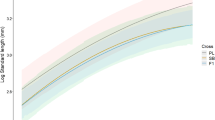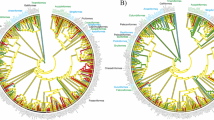Abstract
Theory predicts that variability in size and the shape of a morphological trait should often be stable both at the intra- and interspecific level. We studied variation in beak integration among several populations of two species of the genus Passer, a hybrid species, the Italian sparrow (Passer italiae) and one of its parents, the Spanish sparrow (Passer hispaniolensis). We show that the general shape of the beak has been conserved in these two species and that hybrid speciation has had no major effects on beak integration. However, in young, sympatric populations, phenotypic integration between beak height and length decreased significantly, to the extent that these two dimensions apparently became independent. This displacement in phenotypic integration seems to be accompanied with changes in the distribution of phenotypic variation at the univariate level. This suggests that while beak shape may have been constrained over evolutionary time-scales and major hybridization events (i.e. the formation of the hybrid Italian sparrow), under specific selection regimes linked to secondary contact, it can evolve rapidly.




Similar content being viewed by others
References
Abzhanov, A., Kuo, W. P., Hartmann, C., Grant, R., Grant, P. R., & Tabin, C. J. (2006). The Calmodulin pathway and the evolution of elongated beak morphology in Darwin’s finches. Nature, 442, 563–567.
Adams, D. C. (2010). Parallel evolution of character displacement driven by competitive selection in terrestrial salamanders. BMC Evolutionary Biology, 10, 72.
Benkman, C. W. (2003). Divergent selection drives the adaptive radiations of crossbills. Evolution, 57, 1176–1181.
Björklund, M. (1996). The importance of evolutionary constraints in ecological time scales. Evolutionary Ecology, 10, 423–431.
Campàs, O., Mallarino, R., Herrel, A., Brenner, M. P., & Abzhanov, A. (2010). Scaling and shear transformations capture beak shape variation in Darwin’s finches. Proceedings of the National Academy of Sciences of the United States of America, 107, 3356–3360.
Collyer, M. L., & Adams, D. C. (2007). Analysis of two-state multivariate phenotypic change in ecological studies. Ecology, 88, 683–692.
Darwin, C. (1859). On the origin of species by means of natural selection, or the preservation of favoured races in the struggle for life. London: John Murray.
Davis, J. (1956). Seasonal changes in beak length of certain passerine birds. Condor, 56, 142–149.
Egset, C. K., Bolstad, G. H., Rosenqvist, G., Endler, J. A., & Pélabon, C. (2011). Geographic variation in allometry in the guppy (Poecilia reticulata). Journal of Evolutionary Biology, 24, 2631–2638.
Elgvin, T. O., Hermansen, J. S., Fijarczyk, A., Bonnet, T., Borge, T., Sæther, S. A., et al. (2011). Hybrid speciation in sparrows II, a role for sex chromosomes? Molecular Ecology, 20, 3823–3837.
Ericson, P. G. P., Tyrberg, T., Kjellberg, A. S., Jonsson, L., & Ullén, I. (1997). The earliest record of house sparrows (Passer domesticus) in northern Europe. Journal of Archeological Sciences, 24, 183–190.
Eroukhmanoff, F., Hargeby, A., & Svensson, E. I. (2009). Rapid adaptive divergence between ecotypes of an aquatic isopod inferred from FST–QST analyses. Molecular Ecology, 18, 4912–4923.
Eroukhmanoff, F., Hermansen, J. S., Bailey, R. I., Sæther, S. A., & Sætre, G.-P. (2013). Local adaptation within a hybrid species. Heredity, 111, 286–292.
Eroukhmanoff, F., & Svensson, E. I. (2008). Phenotypic integration and conserved covariance structure in calopterygid damselflies. Journal of Evolutionary Biology, 21, 514–526.
Eroukhmanoff, F., & Svensson, E. I. (2009). Contemporary parallel diversification, antipredator adaptations and phenotypic integration in an aquatic isopod. PLoS ONE, 4(7), e6173.
Eroukhmanoff, F., & Svensson, E. I. (2011). Evolution and stability of the G-matrix during colonization of a novel environment. Journal of Evolutionary Biology, 24, 1363–1373.
Frankino, W. A., Zwaan, B. J., Stern, D. L., & Brakefield, P. M. (2005). Natural selection and developmental constraints in the evolution of allometries. Science, 307, 718–720.
Grant, P. R. (1999). Ecology and evolution of Darwin’s finches. New York: Princeton University Press.
Grant, P. R., & Grant, B. R. (1994). Phenotypic and genetic effects of hybridization on Darwin’s finches. Evolution, 48, 297–316.
Hermansen, J. S., Sæther, S. A., Elgvin, T. O., Borge, T., Hjelle, E., & Sætre, G.-P. (2011). Hybrid speciation in sparrows I, phenotypic intermediacy, genetic admixture and barriers to gene flow. Molecular Ecology, 20, 3812–3822.
Huxley, J. S. (1932). Problems of relative growth. New York: Dover Publications, INC.
Jennions, M. D., & Kelly, C. D. (2002). Geographical variation in male genitalia in Brachyrhaphis episcopi (Poeciliidae), is it sexually or naturally selected? Oikos, 97, 78–90.
Jensen, H., Sæther, B.-E., Ringsby, T. H., Tufto, J., Griffith, S. C., & Ellegren, H. (2003). Sexual variation in heritability and genetic correlations of morphological traits in house sparrow (Passer domesticus). Journal of Evolutionary Biology, 16, 1296–1307.
Kimball, R. T. (1996). Female choice for male morphological traits in house sparrows, Passer domesticus. Ethology, 102, 639–648.
Lack, D. (1947). Darwin’s finches. Cambridge: Cambridge University Press.
Lande, R. (1979). Quantitative genetic analysis of multivariate evolution, applied to brain–body size allometry. Evolution, 3, 402–416.
Pigliucci, M. (2003). Phenotypic integration, studying the ecology and evolution of complex phenotypes. Ecology Letters, 6, 265–272.
Podos, J. (2001). Correlated evolution of morphology and vocal signature in Darwin’s finches. Nature, 409, 185–188.
Renaud, S., Alibert, P., & Auffray, J.-C.-. (2012). Modularity as a source of new morphological variation in the mandible of hybrid mice. BMC Evolutionary Biology, 12, 141.
Riyahi, S., Hammer, Ø., Arbabi, T., Sánchez, A., Roselaar, C. S., Aliabadian, M., et al. (2013). Beak and skull shapes of human commensal and non-commensal house sparrows Passer domesticus. BMC Evolutionary Biology, 13, 200.
Roff, D. A., & Fairbairn, D. J. (2012). A test of the hypothesis that correlational selection generates genetic correlations. Evolution, 66, 2953–2960.
Sætre, G.-P., Riyahi, S., Aliabadian, M., Hermansen, J. S., Hogner, S., Olsson, U., et al. (2012). Single origin of human commensalism in the house sparrow. Journal of Evolutionary Biology, 25, 788–796.
Schluter, D. (1996). Adaptive radiations along genetic lines of least resistance. Evolution, 50, 1766–1774.
Schluter, D. (2000). The ecology of adaptive radiations. New York: Oxford University Press.
Sinervo, B., & Svensson, E. (2002). Correlational selection and the evolution of genomic architecture. Heredity, 89, 329–338.
Summers-Smith, J. D. (1988). The sparrows: A study of the genus Passer. Carlton: T & D Poyser.
Svensson, E. I., & Calsbeek, R. (2012). The adaptive landscape in evolutionary biology. Oxford: Oxford University Press.
Symonds, M. R., & Tattersall, G. J. (2010). Geographical variation in bill size across bird species provides evidence for Allen’s rule. American Naturalist, 176, 188–197.
Trier, C. N., Hermansen, J. S., Sætre, G.-P., & Bailey, R. U. (2014). Evidence for mito-nuclear and sex-linked reproductive barriers between the hybrid Italian sparrow and its parent species. PLoS Genetics, 10, e1004075.
Voje, K. L., & Hansen, T. F. (2013). Evolution of static allometries: Adaptive change in allometric slopes of eye span in stalk-eyed flies. Evolution, 67, 453–467.
Westley, P. A. H. (2011). What invasive species reveal about the rate and form of contemporary change in nature. American Naturalist, 177, 496–509.
Acknowledgments
We thank K. L. Voje and R. I. Bailey for helpful comments and suggestions on earlier drafts of this manuscript. We also thank S. A. Sæther, C. N. Trier, M. H. Tu, M. Moan, A. M. Reynolds, M. Caldarella, and G. Albanese for their invaluable help in collecting this data. This study was financially supported by the Centre for Ecological and Evolutionary Synthesis (CEES) and Molecular Life Sciences (MLS) at the University of Oslo, the Research Council of Norway and the Swedish Research Council.
Conflict of interest
We declare no conflict of interests.
Author information
Authors and Affiliations
Corresponding author
Electronic supplementary material
Below is the link to the electronic supplementary material.
Rights and permissions
About this article
Cite this article
Eroukhmanoff, F., Elgvin, T.O., Gonzàlez Rojas, M.F. et al. Effect of Species Interaction on Beak Integration in an Avian Hybrid Species Complex. Evol Biol 41, 452–458 (2014). https://doi.org/10.1007/s11692-014-9278-3
Received:
Accepted:
Published:
Issue Date:
DOI: https://doi.org/10.1007/s11692-014-9278-3




